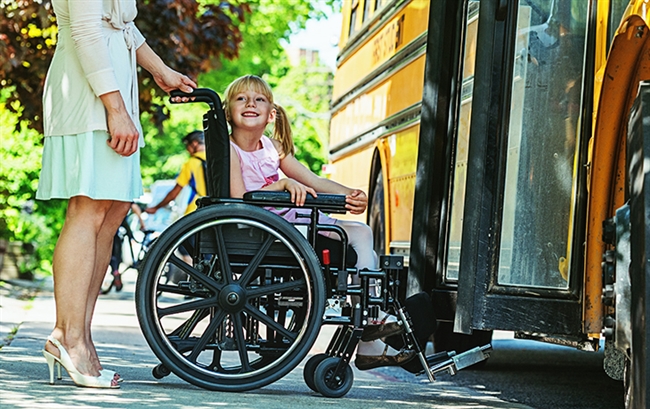Special Needs Driver Training Resources
February 27, 2020 by Kimberly Martin

Transporting students with special needs requires special people. When I reach out to school districts to ask about their training programs for drivers, I am never disappointed. It’s amazing to see that even though states and federal agencies require exceptional training, most every operation goes beyond the standard training for drivers, aides, and students. Since everyone benefits from sharing best practices, I’m eager to share some fresh ideas for driver continuing ed programs.
Recertify Special Needs Drivers Every Year: Similar to required courses for license endorsements, drivers and bus aides take an initial class for special needs transportation, complete with written and hands-on tests. The hands-on test includes demonstrating wheelchair tie downs, drag blanket, evacuation plans, driver and attendant responsibilities, confidentiality, communication, legislation on special needs, first aid, body fluid clean up training, and mandated reporting. They must then take a refresher course each year.
Ensure Knowledge of Wheelchair Securement and Assistive Devices: There is much to learn about wheelchairs alone. Drivers must know the proper way to secure them on the bus and also know how to recognize if a chair is not transportable. They must know how a child should be secured and how to manage other assistive devices like braces, walkers, tracheotomy tubes, IV tubes, oxygen, ventilators, and safety vests.
Here is a link to the Illinois driver training curriculum. Page 121 has the wheelchair securement procedure: Illinois Bus Driver Training Manual
The National Highway Traffic Safety Administration (NHTSA) publishes a wonderful resource called the School Bus Driver In-Service Safety Series that includes instructor guides, PowerPoint slides, and handouts. NHTSA also creates training videos, including this series about Child Safety Restraint Systems (CSRS).
Develop Empathy Training: Drivers are trained on autism, blindness, hearing impairment, cognitive disabilities, orthopedic impairment, emotional disturbance, speech/language impairment, seizures, and more. There is so much to learn about these, and this is where I am extremely passionate about training. What can we learn to make the bus ride the best experience possible for these students? To start, we should learn the difference between empathy and sympathy. Here are some creative ways that Dean Transportation in Michigan is incorporating a unique hands-on approach for drivers to better understand their student’s needs.
Having your drivers and aides ride a bus from the student’s point of view can help them self-evaluate. I used to incorporate similar training at my district with the help of local organizations. For example, our county instructors and I reached out to the Northern Illinois Special Recreation Association (NISRA) who was excited to help offer training to local drivers. We put together a unique Saturday morning program for every driver and aide in the county. In one of the workshop activities, we gave drivers mittens and a flannel shirt with buttons and told them to put it on quick while someone else said, “Hurry up, you’re going to miss the bus!” These transportation employees spent the entire day putting themselves in the shoes of their special needs students in order to provide better service. After the training, they received a special certificate to add to their resumes. The workshop got rave reviews, and we exceeded our attendance goal in the first year!
Create Evacuation Plans and Seating Charts: Evacuation plans are critical to have and keep up to date. Drivers, bus aides, and transportation staff will put together a seating chart for each special need run based on the emergency evacuation plan. The following factors are taken into consideration when putting these plans in place:
- What are each student’s abilities?
- Which students can get off the bus by themselves?
- Which students can be removed from the bus without their wheelchair (or specialized seat)?
- Which students should not be removed from their wheelchair or specialized seat?
- Which students have essential equipment that must also be removed?
- What equipment do you need for an evacuation (e.g., belt cutter, drag blanket, etc.)?
- What personnel will be available to help you? Which students can help others get off the bus?
- Where are emergency services along your route (fire stations, hospitals, and police)?
Written plans should include:
- A diagram of the seating pattern that identifies where each student sits
- Information on how to evacuate each student
- The location of emergency evacuation equipment and exits
Another fantastic resource is the TSD Conference (Transporting Students with Disabilities). The content is unmatched, and the contacts you make will be some of the best resources you can reach out to. We can never prepare for everything, so in our industry, best practices are our guidelines. On the TSD website, you can download a sample letter to give your superiors with ROI information for attending the show.
As a leader in the industry of providing support and offering solutions to simplify the process of providing the safest environment for school bus transportation, Tyler is proud to lead the way when it comes to driver assist devices.
This year you can connect me in person at NAPT conference and NASDPTS conference. During this panel I will be sharing the unique benefits Tyler Drive brings to transporting students with special needs. Or, if you would like to learn more as soon as possible, please reach out to me directly. If you have created school bus driver training that you would like to share, Tyler wants to help be a part of supporting that if possible. Please feel free to contact me and share ideas!